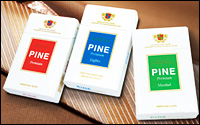KT&G cigarettes massively smuggled into Pakistan
 Billions of KT&G’s Pine brand cigarettes have long been smuggled into Pakistan, most likely from the neighboring Afghanistan, according to multiple sources.
Billions of KT&G’s Pine brand cigarettes have long been smuggled into Pakistan, most likely from the neighboring Afghanistan, according to multiple sources.
The amount of smuggled Pine cigarettes is so substantial that it prompted the Pakistani authorities to formally complain to the Korean government and KT&G last year, according to internal documents obtained by The Korea Times.
KT&G, the nation’s leading tobacco maker, exports to 45 countries, including four countries in the Middle East _ Afghanistan, the United Arab Emirates (UAE), Iraq and Iran _ through the firm’s regional offices and UAE-based importer Alokozay International.
The cigarette maker signed a 566-billion-won tobacco deal with Alokozay in February this year _ up from 524 billion won in 2010.
About 5 billion Pine brand cigarettes have been imported annually into the war-torn Afghanistan by Alokozay, and a significant portion is suspected to have crossed the border into Pakistan.
KT&G does not have any official dealers or representative offices in Pakistan. A pack of 20 cigarettes is said to be sold at around 30 Pakistani rupees (400 won).
The tobacco maker was made aware of the smuggling when Pakistan’s embassy in Seoul raised the issue with Korea’s Ministry of Strategy and Finance in April. A meeting was arranged between the embassy and the tobacco maker.
A KT&G spokesperson said that the company has legally supplied its official agents without violating regional regulations and has little control over distribution by those at the bottom of the supply chain including low-level wholesalers.
There are two reasons why the Pakistani government is concerned with the large-scale smuggle of KT&G’s cigarettes: loss of tax revenue and the lack of health warnings on the cigarette packs.
Pakistan’s tobacco regulations require the packaging be printed with health warnings using visual images or pictures.
KT&G says that the company complies with the regulations of each country it exports to. Iran, for example, demands pictorial warnings while there is no warning requirement for Afghanistan.
That is one of the reasons why the Pine brand cigarettes available in Pakistan are suspected to have come from Afghanistan. The company mentioned the possibility of fake Pine brand cigarettes being manufactured locally.
The KT&G spokesman said that the company is trying to strengthen monitoring of distribution in the region.
“We are planning to carry out field investigations this year in Afghanistan and Pakistan which we couldn’t visit so far because of unfavorable conditions,” he said in a statement in response to The Korea Time’s query on the firm’s measures to deal with Pakistan’s complaint.
“We are making efforts to prevent our products from being smuggled including recently applying to the Ministry of Foreign Affairs and Trade for an entry permit into Afghanistan.”
An official at the Pakistani embassy in Seoul said that since the embassy reported its meeting with KT&G last May to the commerce department in Pakistan, he has not received any further complaints or queries.
Several Pakistani news organizations, however, have covered the issue this year, with some raising suspicions that KT&G is purposely leaving the issue unresolved.
KT&G does not have any plans yet to establish an official dealer in Pakistan. There, its rivals British American Tobacco and Philip Morris International operate under subsidiaries the Pakistan Tobacco Company and Philip Morris Pakistan, respectively.
The Pine brand was first launched in 1999 mainly for export, and has gained much popularity in the Middle East, identified by KT&G as its major export market in an annual financial statement.
Pine is different from the Pine Tree brand of the same company that had been widely popular in Korea among low-income earners due to its cheapness.
Pine Tree cigarettes, launched in 1980 and once manufactured in North Korea to boost economic cooperation between the two Koreas, were sold at as low as 200 won per pack until production ended in 2004 and inventory ran out in 2005. <Korea Times/Kim Da-ye>
























































